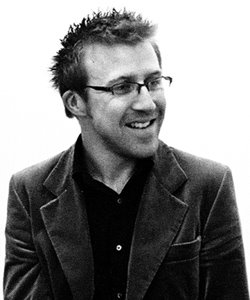Bock and Vincenzi

‘Everything that appears is an image of the invisible.’ - Dance Theatre Journal Vol. 20 no. 3, 2004
Frank Bock (performer / choreographer) and Simon Vincenzi (director / designer) have worked together since 1995. Together they have explored the relationship between the language of movement and mystery of the image through a series of theatre / dance projects. They have undertaken extensive research into notions of absence and nothingness. Information taken from www.artsadmin.co.uk
On the 20th March 2003, in a 'dark' theatre in London's West End, Bock & Vincenzi presented: invisible dances from afar: a show that will never be shown.
In the empty auditorium sat just one person; the poet and theatre maker Fiona Templeton (The Watcher). As she watched, she recorded her experience of this extraordinary two-hour long performance, so that an audience might later hear it on the telephone. The nine performers knew that if they stopped performing their audience would have nothing to describe and that if she stopped talking that the show would disappear. Individually the dancers explored different relationships between the external body, communication technologies and absence. Through personal earpieces they responded to different 'soundtracks' - a specially commissioned work inspired by the internal sounds of the body, specific instructions for the performers' movements based upon journeys undertaken by someone unknown to them. James Brown (The Medium) was also invited to investigate and record the presence of a spirit audience in the theatre building during the performance. Outside the auditorium sat artist Rose English (The Witness), writing about hearing but not seeing the performance. A fourth person, Henrik Thorup Knudsen (The Photographer) documented the entire show from the back of the stage, taking images with the Hasselblad shutter open for the full duration of each of the 36, three minute, 20 second scenes. As 'part of' the show he also took portraits of the performers, capturing their image as they finished presenting work.
This work explored how an audience could experience a physical event that can not be seen; how a poetic world that is open to the personal interpretation of those present is translated; how you describe the indescribable. The vivid and haunting account of The Watcher could be heard as a sound work for the telephone, by dialling the number advertised on fly posters designed by artist Duncan MacAskill. The piece could only ever be heard by telephone and will never be performed in front of an audience.
Interview with Simon Vincenzi commissioned by Dance 4 exploring absence as substance.
MP Michael Pinchbeck
SV Simon Vincenzi
MP How did your research process begin for Invisible Dances?
SV We began by going out and making dance you could perform in the street that noone could see. Like using a bus-stop pole, organising movement in a public space that was invisible as a dance and then bringing that back into the studio. Going out and trying to recall the directions of the streets you were going down.
MP Here, As If They Hadn’t Been, As If They Are Not is a play with no plot, no beginning and no end, that reveals the stories that are contained within the absent body. You describe the piece as ‘Elegiac in its search for narrative’. Why?
SV In Dance Theatre a lot of it has become about stories. In Dance a lot of it is about the body and how it moves. We had no space. No money. So all we had was nothingness. The use of nothingness changed into the idea of absence and stories that are contained within the absent body and how it moves or doesn’t.
MP How do you see the research as sitting alongside or within the practice?
SV Research and creativity blur as a result of people working together for a length of time. The show isn’t fixed – there is no internal structure – it is always different. Because it is always different – we’re always exploring the idea of liveness. Even though it is always different – it still has to be done incredibly precisely.
MP If it is never fixed and not there how do you know when it’s finished?
SV It’s never complete. I don’t know what complete is.
MP Twelve performers, both blind and sighted, present different ‘states’ created and guided by different rules and interpretations of representation. How?
SV We had dancers wearing blindfolds. Dancing with wild abandonment. We filmed them dancing. Then made them watch it. Then got them to recreate a dance that was never made to be recreated. This is a world of abandonment and beauty, exploring appearance and disappearance and whether all is ever visible.


0 Comments:
Post a Comment
<< Home